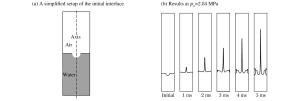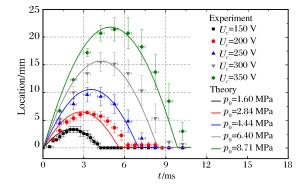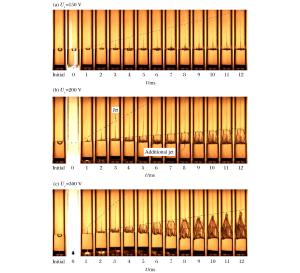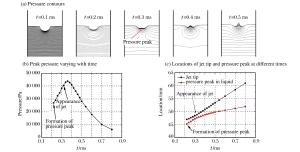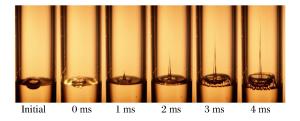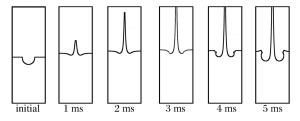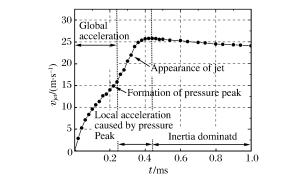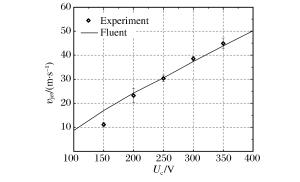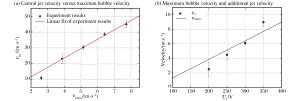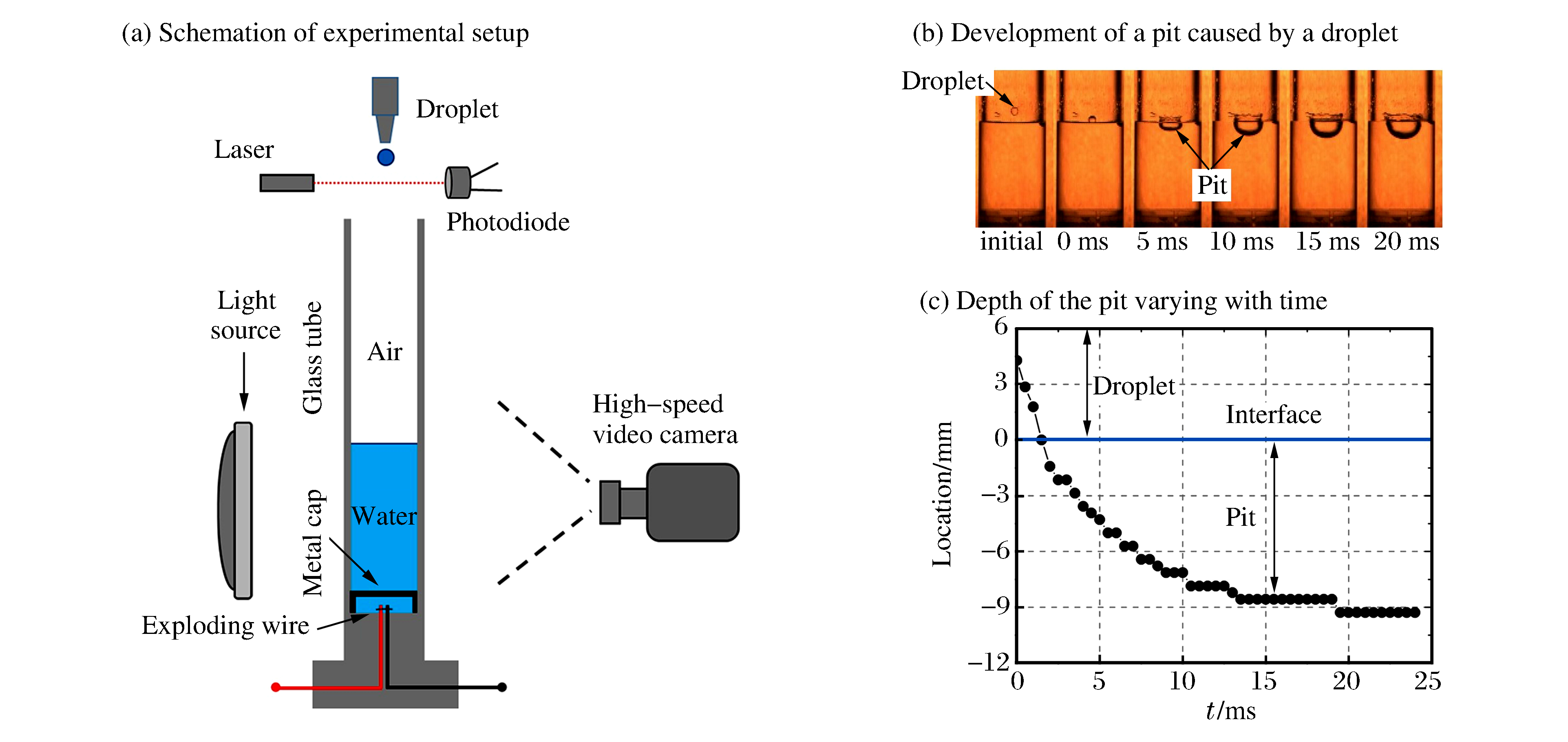A study on jet flow induced by underwater explosion at a pit-interface
-
摘要: 利用液滴坠落冲击直管中水平液面产生半球形凹陷,并以此凹陷液面作为初始界面进行水下爆炸冲击诱导射流的实验研究。以高速摄影为主要手段,结合Fluent数值模拟,揭示了凹陷液面在水下爆炸冲击作用下的变形过程和机理。实验结果表明,随着爆炸的发生,液面凹陷中心会汇聚形成纤细光滑的射流,同时在管壁附近会产生附加环状射流,这明显区别于冲击直管中水平液面诱导射流的现象。进一步研究发现,中心射流的产生主要源于液面凹陷对爆炸能量的汇聚作用,而附加射流的产生受到液面初始形状和管壁剪切阻力的共同影响,二者经历短暂的加速过程之后均以一个近似恒定的速度向上抬升。通过考察能量对射流的影响发现,中心射流与附加射流的速度均与充电电压(爆炸能量的1/2次方)呈线性正相关;中心射流形态特征基本不变,附加射流则随能量的变化呈现不同的形态。Abstract: In this study we conducted an experiment on the jetting flow induced by underwater wire explosion at an interface with a quasi-static hemispherical pit, in which the interfacial pit was created by the dripping of a liquid drop. Further, using high-speed video photography and Fluent numerical simulation, we revealed the development and features of the jetting flow, tested and verified the applicability of the pit creation method. The experimental results show that the explosion induces a slim and smooth central jet that arises from the bottom of a pit, and a circular side jet arises from the boundary region of the tube, which differs from the known jetting phenomenon without a pit at the surface. Further study reveals the central jet is a result of the energy concentration effect of the pit under impact and the circular side jet is caused by a combined effect of the disturbed initial interface and the friction of the tube wall. Both jets rise with an early constant velocity after a short acceleration process. Examination of the explosion energy indicates that the velocities of the two jets increase linearly with the charging voltage (or equivalently the square root of the explosion energy).The explosion energy barely affects the general feature of the central jet but has a significant influence on the appearance of the side jet.
-
Key words:
- jet /
- underwater explosion /
- straight tube /
- falling droplet /
- pit
-
表 1 各个工况的模拟压力和对应的实验充电电压
Table 1. Initial pressure of simulation corresponding to charging voltage of experiments
工况 p0/MPa Uc/V 1 1.60 150 2 2.84 200 3 4.44 250 4 6.40 300 5 8.70 350 -
[1] ASAY J R. Material ejection from shock-loaded free surfaces of aluminum and lead[R]. Albuquerque, NM, USA: Sandia Labs, 1976. http://adsabs.harvard.edu/abs/1976mesl.rept.....A [2] VOGAN W S, ANDERSON W W, GROVER M, et al. Piezoelectric characterization of ejecta from shocked tin surfaces[J]. Journal of Applied Physics, 2005, 98(11):113508. doi: 10.1063/1.2132521 [3] ZELLNER M B, GROVER M, HAMMERBERG J E, et al. Effects of shock-breakout pressure on ejection of micron-scale material from shocked tin surfaces[J]. Journal of Applied Physics, 2007, 102(1):013522. doi: 10.1063/1.2752130 [4] CHEN Y, HU H, TANG T, et al. Experimental study of ejecta from shock melted lead[J]. Journal of Applied Physics, 2012, 111(5):053509. doi: 10.1063/1.3692570 [5] 王裴, 秦承森, 张树道, 等.SPH方法对金属表面微射流的数值模拟[J].高压物理学报, 2004, 18(2):149-156. doi: 10.11858/gywlxb.2004.02.014WANG Pei, QIN Chengsen, ZHANG Shudao, et al. Simulated microjet from free surface of aluminum using smoothed particle hydrodynamics[J]. Chinese Journal of High Pressure Physics, 2004, 18(2):149-156. doi: 10.11858/gywlxb.2004.02.014 [6] 刘超, 王裴, 秦承森, 等.冲击压力及加载速率对沟槽微射流的影响[J].计算物理, 2010, 27(2):190-194. http://www.wanfangdata.com.cn/details/detail.do?_type=perio&id=jswl201002005LIU Chao, WANG Pei, QIN Chengsen, et al. Effect of pressure and shock wave risetime on material ejection[J]. Chinese Journal of Computational Physics, 2010, 27(2):190-194. http://www.wanfangdata.com.cn/details/detail.do?_type=perio&id=jswl201002005 [7] SHAO J L, WANG P, HE A M, et al. Atomistic simulations of shock-induced microjet from a grooved aluminium surface[J]. Journal of Applied Physics, 2013, 113(15):153501. doi: 10.1063/1.4801800 [8] DURAND O, SOULARD L. Large-scale molecular dynamics study of jet breakup and ejecta production from shock-loaded copper with a hybrid method[J]. Journal of Applied Physics, 2012, 111(4):044901. doi: 10.1063/1.3684978 [9] BLAKE J R, TAIB B B, DOHERTY G. Transient cavities near boundaries: Part 1: Rigid boundary[J]. Journal of Fluid Mechanics, 1986, 170:479-497. doi: 10.1017/S0022112086000988 [10] BLAKE J R, TAIB B B, DOHERTY G. Transient cavities near boundaries: Part 2: Free surface[J]. Journal of Fluid Mechanics, 1987, 181:197-212. doi: 10.1017/S0022112087002052 [11] BLAKE J R, Gibson D C. Cavitation bubbles near boundaries[J]. Annual Review of Fluid Mechanics, 1987, 19(1):99-123. doi: 10.1146/annurev.fl.19.010187.000531 [12] DADVAND A, KHOO B C, SHERVANI-TABAR M T. A collapsing bubble-induced microinjector: an experimental study[J]. Experiments in Fluids, 2009, 46(3):419-434. doi: 10.1007/s00348-008-0568-3 [13] ZHANG A M, CUI P, WANG Y. Experiments on bubble dynamics between a free surface and a rigid wall[J]. Experiments in Fluids, 2013, 54(10):1-18. doi: 10.1007/s00348-013-1602-7 [14] ZHANG A M, CUI P, CUI J, et al. Experimental study on bubble dynamics subject to buoyancy[J]. Journal of Fluid Mechanics, 2015, 776:137-160. doi: 10.1017/jfm.2015.323 [15] ZHANG S, WANG S P, ZHANG A M. Experimental study on the interaction between bubble and free surface using a high-voltage spark generator[J]. Physics of Fluids, 2016, 28(3):032109. doi: 10.1063/1.4944349 [16] ANTKOWIAK A, BREMOND N, LE DIZES S, et al. Short-term dynamics of a density interface following an impact[J]. Journal of Fluid Mechanics, 2007, 577(577):241-250. http://cat.inist.fr/?aModele=afficheN&cpsidt=18699835 [17] ANTKOWIAK A, BREMOND N, DUPLAT J, et al. Cavity jets[J]. Physics of Fluids, 2007, 19(9):91112-91700. doi: 10.1063/1.2775413 [18] TAGAWA Y, OUDALOV N, VISSER C W, et al. Highly focused supersonic microjets[J]. Physical Review X, 2012, 2(3):031002. doi: 10.1103/PhysRevX.2.031002 [19] PETERS I R, TAGAWA Y, OUDALOV N, et al. Highly focused supersonic microjets: numerical simulations[J]. Journal of Fluid Mechanics, 2013, 719(1):587-605. https://www.cambridge.org/core/journals/journal-of-fluid-mechanics/article/div-classtitlehighly-focused-supersonic-microjets-numerical-simulationsdiv/7A9E524D0031CDC97ADC24AC356AAE5A [20] KIYAMA A, TAGAWA Y, ANDO K, et al. Effects of a water hammer and cavitation on jet formation in a test tube[J]. Journal of Fluid Mechanics, 2016, 787(2):224-236. http://adsabs.harvard.edu/abs/2016JFM...787..224K [21] KOITA T, ZHU Y, SUN M. Experimental study of the water jet induced by underwater electrical discharge in a narrow rectangular tube[J]. Shock Waves, 2016, 27(2):1-14. doi: 10.1007/s00193-016-0654-z [22] 张桂夫, 朱雨建, 李元超, 等.狭长直管约束条件水下电爆炸所产生的气泡运动和界面射流[J].爆炸与冲击, 2015, 35(5), 609-616. doi: 10.11883/1001-1455(2015)05-0609-08ZHANG Guifu, ZHU Yujian, LI Yuanchao, et al. Bubble and jet induced by underwater wire explosion in narrow tube[J]. Explosion and Shock Waves, 2015, 35(5), 609-616. doi: 10.11883/1001-1455(2015)05-0609-08 [23] ZHANG G, ZHU Y, YANG J, et al. Liquid jets produced by an immersed electrical explosion in round tubes[J]. Physics of Fluids, 2017, 29(6):062102. doi: 10.1063/1.4984801 -






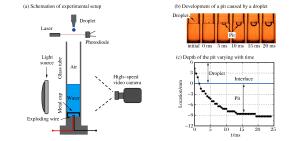
 下载:
下载:
